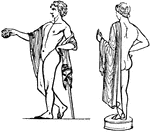Clipart tagged: ‘Chalamys’

Chlamys
"A scarf, denoted an article of the amictus, or outer raiment of the Greeks. It was for the most part…

"A scarf, denoted an article of the amictus, or outer raiment of the Greeks. It was for the most part…